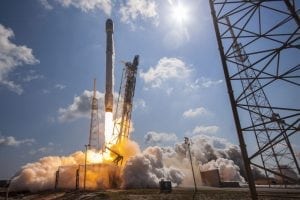Latest News
[Via Satellite 06-16-2016] SpaceX completed the launch of two all-electric satellites June 15 using a Falcon 9 full-thrust rocket. The satellites, ABS 2A for ABS and Eutelsat 117 West B for Eutelsat, are the second in a set of all-electric satellites purchased from Boeing. The satellite design gives them lighter mass by ditching the need to carry lots of fuel, enabling the dual launch, with the trade off of having to take more time to climb from Geostationary Transfer Orbit (GTO) to Geostationary Earth Orbit (GEO).
Eutelsat reports it will take approximately seven months of in-orbit raising for its satellite to reach GEO. The satellite carries 48 Ku-band transponders, providing coverage over Latin America, as well as Raytheon’s Wide Area Augmentation System (WAAS) hosted payload, to enable the U.S. Federal Aviation Administration (FAA) to increase GPS signal accuracy for enhanced aviation safety in North America.
ABS 2A is equipped with an all Ku-band payload of 48 transponders connecting Africa, the Middle East, Russia, South Asia and South East Asia regions. The satellite will be collocated with ABS 2 and will deliver enhanced broadcast and data services from 75 degrees east.
After delivering the satellites to orbit, SpaceX attempted to land the Falcon 9’s first stage on one of the company’s droneships. The landing, which company CEO and Lead Designer Elon Musk described on Twitter as “maybe the hardest impact to date,” was unsuccessful, though the droneship remains intact.
Get the latest Via Satellite news!
Subscribe Now